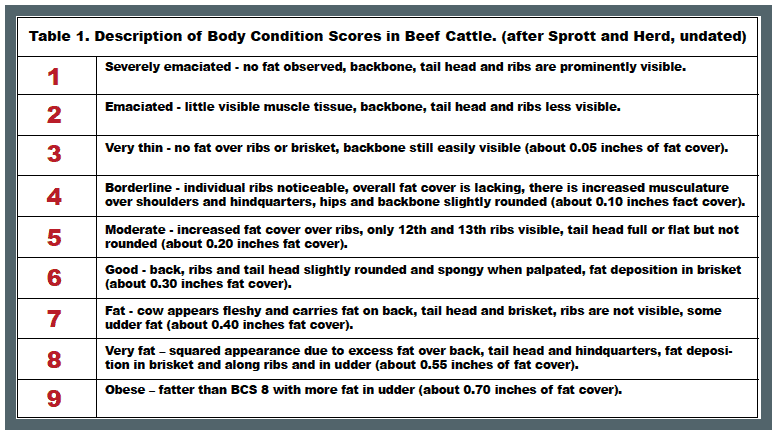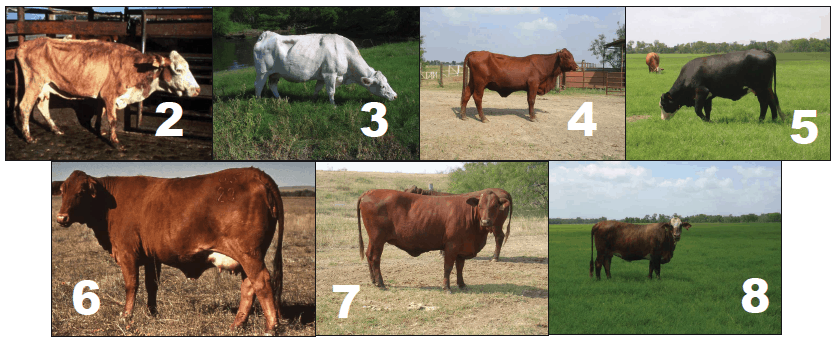Some Thoughts on Body Condition Scoring of Cows
by Texas A&M AgriLife Extension Livestock Specialist Joe C. Paschal, PhD.
As far as technologies go, body condition scoring is one of the most useful and least expensive. No computers, no scales – heck, you don’t even have to pen your cows to apply it. Although body condition was certainly used before the 1960s, I think the late Jim Wiltbank, PhD. at the Texas Agricultural Research Sub-Station No. 1 in Beeville, Texas was one of the first to apply it to subsequent reproductive success. He scored cooperator herds in the South Texas and Gulf Coast on a simple basis: Thin, Average or Fat before calving and found that the average and fat cows had higher pregnancy rates at next breeding. Since then, body condition scores have been more accurately associated with fat cover or lack of it and have been expanded to nine scores (see Table 1) although dairy operators and Australians use a five-point score. In spite of the fact that body condition score (BCS) has been useful to determine breed back or pregnancy rate for over 50 years, a recent National Animal Health Monitoring Survey and my own survey data show that less than 15 percent of beef producers use it.

BCS should be applied to pregnant cows and open heifers about 60 days prior to calving for cows or breeding for heifers. This will give you some time to separate and supplement those that are less than BCS six. BCS is very useful in sorting heifers and cows that have a good chance of coming into heat or responding to estrus synchronization. Females in poor body condition often don’t respond to synchronization very well if at all.
In the range of BCS four to seven, there is a difference of about 8 percent body weight between each score so a 1200-pound cow that would normally be a BCS five would weigh about 100 pounds less as BCS four. She would need to be supplemented almost 1,000 pounds of supplement to gain that weight back, so she will need some time. Bulls can be scored as well since fatness also affects their reproductive performance.
The benefits of BCS include increased pregnancy rate of cows that have calved but there are others as well. Research has shown that cows that calve in higher (but not obese) BCS have less difficulty at calving, provide a higher quality and quantity of colostrum for their calves, and have a higher rebreeding rate. Usually it takes a cow about 45 days for her reproductive tract to go through a period of reinvolution where it returns to normal size and shape and she begins to cycle. Cows that are in lower BCS, below five, at calving have longer reinvolution periods and take longer to rebreed. This is important since, in order to get cows and heifers to rebreed within 365 days after a 283-day gestation, they only have 82 days to rebreed. If it takes them 60 days to return to heat after calving, you only have two chances (22 days) to keep them in an annual calving interval. Cows in BCS of five or better can reinvolute within 35 days, adding 47 days or two additional heat cycles.
Body condition scoring is not difficult and it can be used to monitor supplementation and grazing management programs as well as potential to breed or rebreed. There are smart phone apps that are available for free and I would recommend photographing certain cows and certain BCS for reference in the future.
When body condition scoring, some things to consider including are 1) age (older cattle carry less fat over their backs), 2) breed (Bos indicus and dairy cattle carry less external and more internal fat than Bos taurus), 3) hair (long hair hides lack of condition and muscle), 4) frame size (small and moderate framed cattle tend to be scored higher than large frame cows), 5) gut fill (over emphasis on fill increases BCS), and 6) mud (which can hide the lack of condition and muscle). When scoring heavy-bred females 60 days before calving, don’t confuse pregnancy with fatness.
Although BCS is not highly heritable, research at the US Meat Animal Research Center estimated the heritability of cow body condition score at 0.16), cow BCS taken at the same time each year under the same conditions (barring drought or illness) is repeatable (0.30) meaning that cows that are in good body condition tend to remain in good body condition year after year if raised under the same circumstances. I think we call these types of cows easy keepers. Although BCS is not highly heritable it can be selected for and should be recorded and reported so that you can evaluate it and her performance from year to year.



